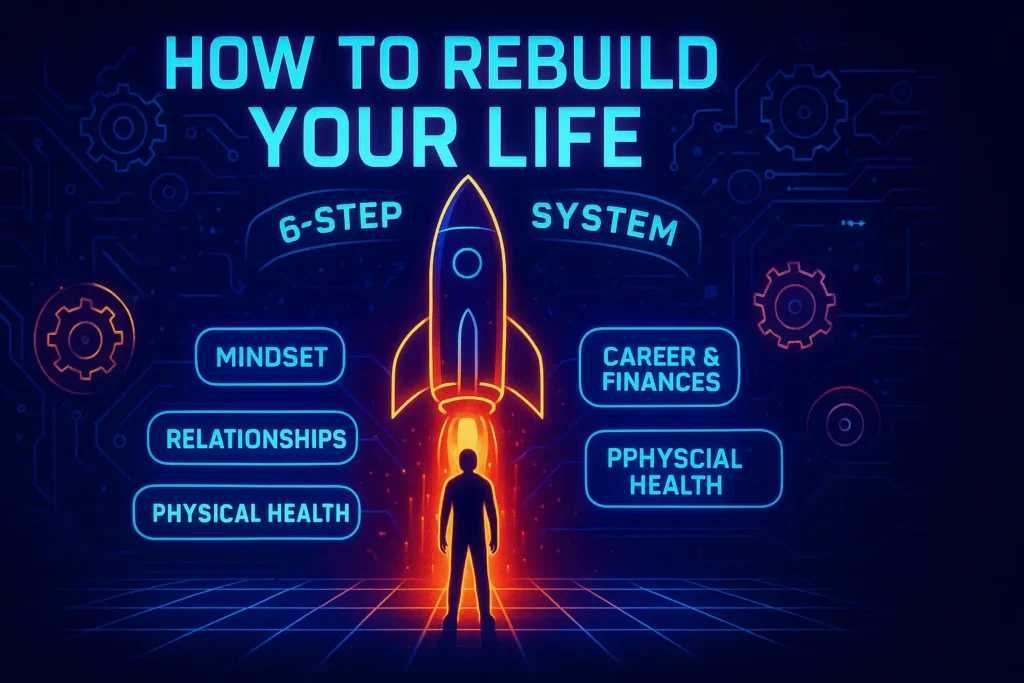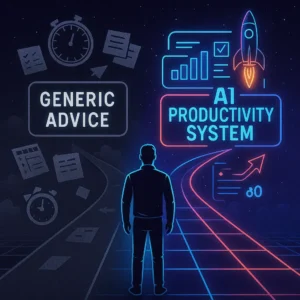Sarah stared at the wreckage of her life—divorce papers on the kitchen table, a pink slip from her job of eight years, and a bank account that barely covered next month’s rent. At 34, she felt like she was starting from absolute zero. Traditional self-help books offered generic advice like “think positive” and “set goals,” but none addressed her specific combination of challenges.
That’s when Sarah discovered something that changed everything: an AI-powered approach to rebuilding yourself that doesn’t rely on willpower, generic advice, or one-size-fits-all solutions. Instead of guessing what might work, she used AI to create a personalized roadmap that addressed her unique situation.
Six months later, Sarah had landed a better-paying job in a new field, developed unshakeable daily routines, and built the confidence to start dating again. The difference wasn’t motivation or luck—it was having a system that made transformation inevitable rather than hopeful.
Most people who want to rebuild their life fail not because they lack determination, but because they’re using outdated methods designed for generic situations rather than their specific circumstances. How to rebuild your life successfully requires personalization at a level that only AI can provide.
AI-Powered Upgrades That Change Everything:
- Personalized habit identification that adapts to your unique situation, schedule, and personality rather than generic recommendations
- Science-backed methods that eliminate guesswork from rebuilding yourself by using proven behavioral psychology tailored to your specific challenges
- Systematic approach that makes transformation inevitable, not hopeful, by creating momentum that compounds across all areas of your life
The Science Behind Rebuilding Your Life
Research from Stanford University’s Behavior Design Lab reveals why most rebuilding life attempts fail: they rely on generic strategies that ignore individual circumstances, personality traits, and lifestyle factors. Dr. BJ Fogg’s studies show that successful behavior change requires three elements working together—motivation, ability, and triggers—but these must be calibrated to each person’s unique profile.
This is where artificial intelligence becomes a game-changer. While traditional approaches offer the same advice to everyone, AI can analyze your specific situation, identify patterns you might miss, and recommend strategies proven to work for people with similar challenges and constraints. It’s like having a behavioral scientist who knows your complete history and can predict what will actually work for you.
The process of rebuilding yourself isn’t just about changing habits—it’s about rewiring your identity across interconnected life areas. When AI helps you understand these connections and creates a personalized strategy, transformation shifts from a hopeful wish to an inevitable outcome. The technology doesn’t just tell you what to do; it shows you exactly how to do it in a way that fits your life.
Modern neuroscience confirms that our brains are remarkably adaptable, but only when change happens in the right sequence and with the right supports. AI excels at identifying these optimal pathways, making rebuilding your life a systematic process rather than a series of random attempts.
Read More: How to Start Over in Life
How to Rebuild Your Life: 6-Step System
Step 1: Assess Your Current Reality
Before you can rebuild your life, you need an honest assessment of where you stand today. This isn’t about dwelling on failures or trauma—it’s about creating a clear baseline that informs your strategy moving forward.
Start by examining five core areas of your life: mindset, career and finances, relationships, physical health, and emotional wellbeing. For each area, identify what’s working, what’s broken, and what’s merely neglected. The key is specificity rather than general statements like “my life is a mess.”
Write down concrete examples. Instead of “my relationships are bad,” specify “I haven’t had a meaningful conversation with my sister in three months” or “I avoid social situations because I feel anxious.” This level of detail becomes crucial when AI helps you identify patterns and root causes.
Most people skip this step because it feels overwhelming or depressing, but understanding your starting point is essential for rebuilding yourself effectively. You can’t navigate to a destination without knowing where you currently are.
Step 2: Define Your 5 Core Areas of Life
Successful life rebuilding requires understanding that everything in your life is interconnected. The five core areas—mindset, career and finances, relationships, physical health, and emotional wellbeing—function like the thrusters of a rocket ship. When one fails, it affects all the others.
Your mindset core serves as your control room, determining how you perceive and respond to challenges. A growth-oriented mindset sees setbacks as temporary and learns from failure, while a fixed mindset gets stuck in victim mode.
The career and finances core isn’t just about making money—it’s about aligning your work with your purpose while building financial security. When this area is strong, it provides resources and confidence that support growth in other areas.
Your relationships core encompasses family, friends, romantic partnerships, and professional connections. Strong relationships provide emotional support and accountability during the rebuilding life process.
The physical health core affects everything else. When you feel strong and energetic, you’re better equipped to handle stress, think clearly, and maintain emotional stability.
Finally, your emotional and mental health core determines your ability to manage stress, express creativity, and find meaning in daily life.
Understanding these connections helps you see why fixing just one area rarely creates lasting change. True transformation happens when you build momentum across all five cores systematically.
Step 3: Identify Your Pain Points and Root Causes
Surface-level problems often mask deeper issues. Someone struggling with weight might think they need better willpower, when the real issue is using food to cope with work stress or relationship problems. Rebuilding yourself requires getting to the root causes rather than just treating symptoms.
Use the “5 Whys” technique to dig deeper. If you’re struggling financially, ask why. Maybe it’s because you overspend. Why do you overspend? Perhaps you use shopping to feel better. Why do you need to feel better? Maybe work stress is overwhelming. Keep drilling down until you reach the fundamental issue.
AI excels at identifying these hidden connections by analyzing patterns across multiple life areas. It might notice that your financial stress correlates with relationship conflicts, which intensify during certain times of year or after specific triggers.
The ripple effect works both ways—negative patterns in one area create problems elsewhere, but positive changes also compound across areas. This is why identifying the right starting point is crucial for rebuilding your life efficiently.
Prioritize pain points that affect multiple core areas. Addressing chronic sleep deprivation, for example, might simultaneously improve your physical health, emotional regulation, and career performance. These high-leverage problems offer the biggest return on your rebuilding efforts.
Read More: 15 Questions to Discover Your Life Purpose
Step 4: Create Your Golden Habit Strategy
Not all habits are created equal. A “golden habit” is one that addresses your biggest pain point while creating momentum across multiple life areas. It’s your highest-leverage starting point for rebuilding life systematically.
For someone rebuilding their life after trauma, a golden habit might be a morning routine that combines mindfulness, physical movement, and goal-setting. This single habit could simultaneously address anxiety (emotional core), improve energy (physical core), and build confidence (mindset core).
The key is choosing a habit that feels achievable but meaningful. Starting too big leads to failure and discouragement. Starting too small might build consistency but won’t create the momentum needed for significant change.
Your golden habit should also align with your natural tendencies and current lifestyle. A morning person might choose a dawn workout routine, while a night owl might focus on an evening reflection practice. AI can analyze your patterns and preferences to suggest habits with the highest probability of success.
Once you’ve identified your golden habit, design it using the three momentum boosting methods: make it obvious (clear triggers and cues), make it easy (remove friction and obstacles), and make it rewarding (immediate positive feedback).
Remember, this is just the starting point. As your golden habit becomes automatic, you’ll add complementary habits that reinforce your progress across all five core areas.
Related Article: Keystone Habits
Step 5: Implement Science-Backed Momentum Methods
Traditional willpower-based approaches to rebuilding yourself fail because they rely on a finite resource that depletes throughout the day. Instead, successful habit formation leverages environmental design, behavioral triggers, and reward systems that work automatically.
Make it Obvious: Design your environment so the desired behavior is the most prominent choice. If you want to exercise in the morning, lay out your workout clothes the night before and keep your equipment visible. Remove triggers for unwanted behaviors—delete social media apps if they’re causing comparison and depression during your rebuilding life phase.
Make it Easy: Reduce friction for good habits and increase it for bad ones. Prep healthy meals on Sunday so eating well requires no daily decisions. Set up automatic transfers to savings accounts so building financial security happens without thinking. Use habit stacking by attaching new behaviors to existing routines.
Make it Rewarding: Create immediate positive feedback for completing your habits. This might be as simple as checking items off a list or treating yourself to something small after completing your routine. The key is linking the behavior to instant gratification while you wait for long-term results to appear.
These methods work because they align with how your brain naturally forms habits. Instead of fighting your psychology, you’re designing an environment where good choices become automatic and bad choices require conscious effort.
AI can help optimize these methods for your specific situation, identifying the most effective triggers, the optimal difficulty level, and the most motivating rewards based on your personality and preferences.
Step 6: Track Progress and Adapt Your System
Rebuilding your life is not a linear process. You’ll face setbacks, discover new challenges, and need to adjust your approach as circumstances change. The key is building a system that learns and adapts rather than rigidly following a predetermined plan.
Track leading indicators, not just outcomes. Instead of only measuring weight loss, track daily exercise completion and meal prep consistency. Instead of only tracking income, monitor skill-building activities and networking efforts. These behavioral metrics give you control over your progress and early warning signs when you’re off track.
Use weekly reviews to assess what’s working and what isn’t. If you consistently skip your morning routine, the problem might be going to bed too late or trying to do too much at once. Adjust the system rather than pushing harder with willpower.
Monthly assessments should examine progress across all five core areas. Sometimes success in one area (like career advancement) can temporarily destabilize another (like relationships or health). Recognizing these trade-offs early allows you to rebalance before problems compound.
The goal isn’t perfection—it’s building a system that helps you navigate challenges and maintain momentum over time. Rebuilding yourself is an ongoing process of growth and adaptation, not a destination you reach and then maintain through willpower alone.
AI-powered tracking takes this to the next level by identifying patterns you might miss and suggesting adjustments based on data from your specific situation and similar successful cases.
Read More: How to Be Productive
AI Prompt to Accelerate Your Life Rebuilding
Copy and paste this comprehensive prompt into ChatGPT, Claude, or any advanced AI assistant to get personalized guidance for how to rebuild your life:
AI CONVERSATION STARTER:
“I want to systematically rebuild my life using a science-based, personalized approach. Please act as an expert life strategist and guide me through a comprehensive assessment and planning process.
Step 1: Current Reality Assessment Help me evaluate my current situation across five core areas:
- Mindset: How do I typically respond to setbacks? What limiting beliefs hold me back?
- Career & Finances: What’s my current work/income situation and relationship with money?
- Relationships: How would I describe the quality of my key relationships?
- Physical Health: What’s my current energy level, fitness, and health status?
- Emotional Wellbeing: How do I manage stress and find meaning in daily life?
For each area, ask me specific questions to understand what’s working, what’s broken, and what’s neglected.
Step 2: Pain Point Identification Based on my responses, help me identify:
- The top 3 pain points affecting my quality of life
- How these problems connect across different life areas
- Which issue, if solved, would create the most positive ripple effects
Step 3: Golden Habit Strategy Recommend a single ‘golden habit’ that:
- Addresses my biggest pain point
- Fits my schedule and preferences
- Creates momentum across multiple life areas
- Feels achievable but meaningful
Step 4: Implementation Design For my golden habit, help me:
- Design environmental triggers and cues
- Remove obstacles and friction points
- Create immediate rewards and feedback systems
- Plan for common obstacles and setbacks
Step 5: Tracking and Adaptation Suggest specific metrics to track and a review schedule for adjusting my approach based on what’s working.
Please start with Step 1 and wait for my responses before moving to each next step. Ask detailed follow-up questions to understand my unique situation, and provide specific, actionable recommendations rather than generic advice.”
For best results with this AI prompt:
- Be completely honest in your responses—AI can only help based on accurate information
- Provide specific examples rather than general statements
- Ask follow-up questions when recommendations aren’t clear
- Use this as a starting point and return to refine your approach as you progress
This prompt transforms AI from a generic advice-giver into a personalized strategist that understands your unique situation and provides tailored guidance for rebuilding life systematically.
How to Rebuild Your Life: Real-World Implementation
Marcus hit rock bottom after losing his business, going through a bitter divorce, and developing anxiety so severe he couldn’t leave his apartment some days. At 42, he felt like his entire identity had crumbled and wasn’t sure where to begin rebuilding his life after trauma.
Using the six-step system, Marcus started with an honest assessment that revealed his core issues: financial panic, social isolation, and a fixed mindset that saw his failures as permanent. His AI-guided analysis identified that addressing his morning anxiety spiral would create the biggest positive impact across all life areas.
His golden habit became a simple 15-minute morning routine: five minutes of breathing exercises, five minutes writing three priorities for the day, and five minutes of gentle stretching. This habit simultaneously addressed his anxiety, gave him a sense of control, and improved his energy.
The AI prompt helped him design environmental supports: preparing his journal and yoga mat the night before, using a meditation app with his favorite guided breathing exercises, and celebrating completion by making his favorite coffee blend. When he missed days due to bad anxiety, the system helped him adjust by creating an even simpler backup version.
Six months later, Marcus had launched a consulting business, started dating again, and developed the emotional resilience. The transformation wasn’t magic—it was the compound effect of one well-designed habit creating momentum across all areas of his life. His morning routine became the foundation that supported increasingly ambitious goals and rebuilding himself from the inside out.
Read More: How to Reinvent Yourself
Conclusion: How to Rebuild Your Life After Trauma
Rebuilding your life doesn’t have to be an overwhelming or uncertain process. With the right system—one that combines proven behavioral science with AI-powered personalization—transformation becomes inevitable rather than hopeful. The six-step framework provides the structure, while AI provides the customization that makes it work for your unique situation. Start with one golden habit, trust the process, and watch as momentum builds across all five core areas of your life. Your rebuilt life is waiting—you just need the right system to get there.
✨ YOUR PERSONALIZED LIFE REBUILDING SYSTEM IS JUST A FEW CLICKS AWAY
You’ve just discovered the power of systematic, AI-enhanced life rebuilding, but this is only the beginning of what’s possible when you combine behavioral science with cutting-edge personalization technology.
This approach is powered by Moore Momentum’s HabitsCoach AI—a gamified, AI-driven platform that transforms rebuilding your life from an overwhelming challenge into an engaging, inevitable journey. Instead of generic advice, you get a personalized system that adapts to your unique situation, tracks your progress across all five core areas, and provides the accountability needed to make lasting change.
The platform combines everything you’ve learned here with advanced features like habit stacking strategies, social accountability, progress gamification, and continuous AI optimization based on your results. Whether you’re rebuilding yourself after trauma, or simply want to upgrade your current situation, the system makes transformation easy.






